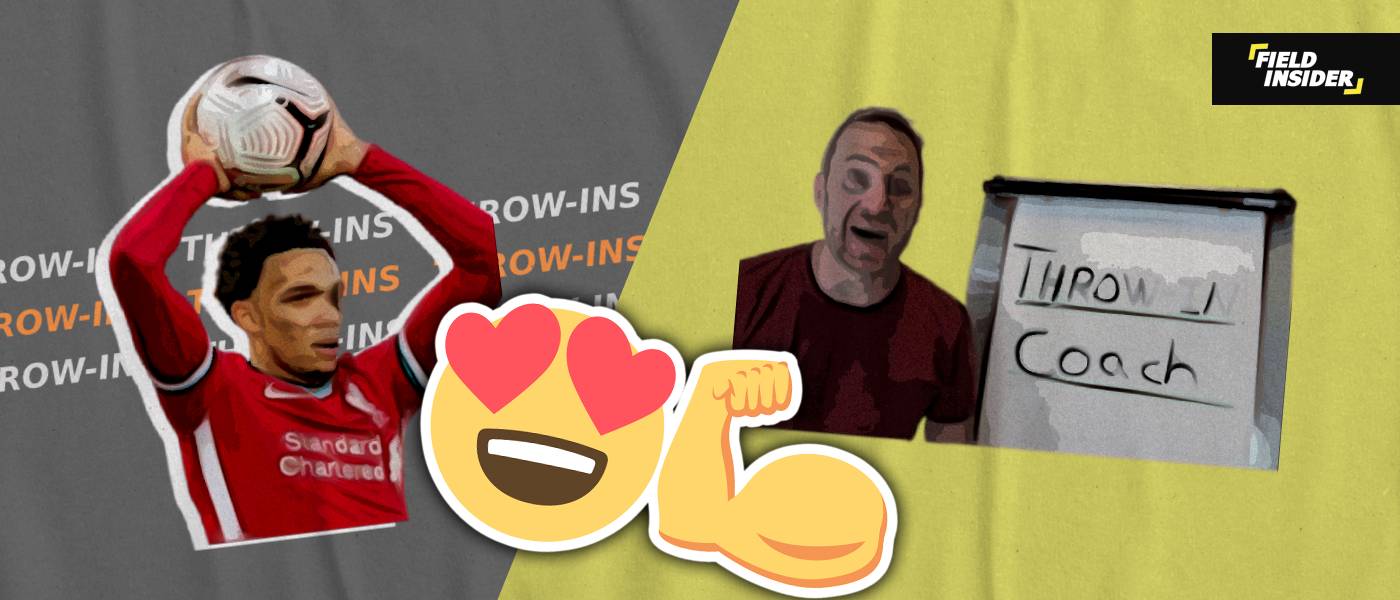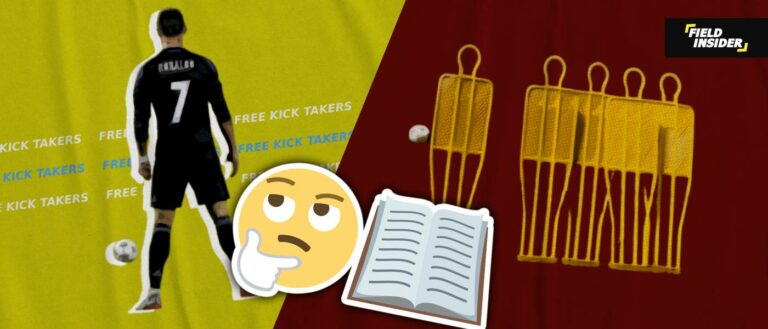What Are The Football Throw-In Rules? A Complete Guide
In the dynamic world of football, throw-ins hold a unique place, often overlooked yet pivotal in shaping the game’s flow. This guide delves into the nuances of throw-in rules, a fundamental yet complex aspect of football.
By understanding these rules, players and enthusiasts can appreciate the strategic importance of throw-ins in the game’s overall fabric.
Key Takeaway Table
| Aspect | Details |
|---|---|
| Definition | A method to restart play when the ball crosses the touchline. |
| Awarding | Given to the team not responsible for the ball going out. |
| Purpose | To resume the game and provide strategic opportunities. |
| Rule Importance | Ensures fairness and continuity in the game. |
The Basics of Throw-Ins
A throw-in occurs when the ball crosses the touchline, and the team not responsible for its exit is awarded the chance to throw the ball back into play. It’s a crucial restart mechanism in football, ensuring the game’s continuity and offering strategic opportunities.

What is a throw-in?
A Football throw-in is the act of throwing the ball back into play to restart the game. Once the whole ball goes out of the field of play. If the player of one team is the last person to touch the ball. Then a player of the other team takes the throw-in.
The convention is that the wing-back usually takes the throw-in. Because he is usually closest to the scene. And frees up the winger or other advanced players to help teams attack from the throw-in.
Also, the attackers are trained to win the first headers from the throw-ins and retain possession for the team. Which seems to be a significant objective of football throw-ins presently.
Why is a throw-in thrown with your hands?
This is a genuine question. Why is the game restarted by a throw using the hands when the game being played is football, and penalties are given when a player uses their hand? The reason for this seems to be the close relationship between football and rugby.
These field games have a lot in common. Since both these games started to develop together in the United Kingdom, many of the elements were exchanged. As such, the football throw-ins seem to be a variation of the lineout in rugby, which is when the game is restarted as the ball goes out of play. Seems familiar doesn’t it?
The Throw-In Technique
A throw-in, while appearing straightforward, is a skill that requires precision and adherence to specific rules. The manner in which a player executes a throw-in can significantly influence the game’s flow, creating opportunities for attack or maintaining possession.
Proper Execution of a Throw-In
To execute a legal throw-in, a player must:
- Positioning of Feet: The player’s feet must be on or behind the touchline. This means part of each foot must either be on the line or in the area outside the field of play. The feet cannot completely cross the touchline into the field of play.
- Handling the Ball: The ball must be held with both hands from behind and over the head. This ensures a fair and standard method of throwing across all players and matches.
- Ball Release: The ball must be released from over the head. A common mistake is releasing the ball from the side of the head or at a lower height, leading to a foul throw.
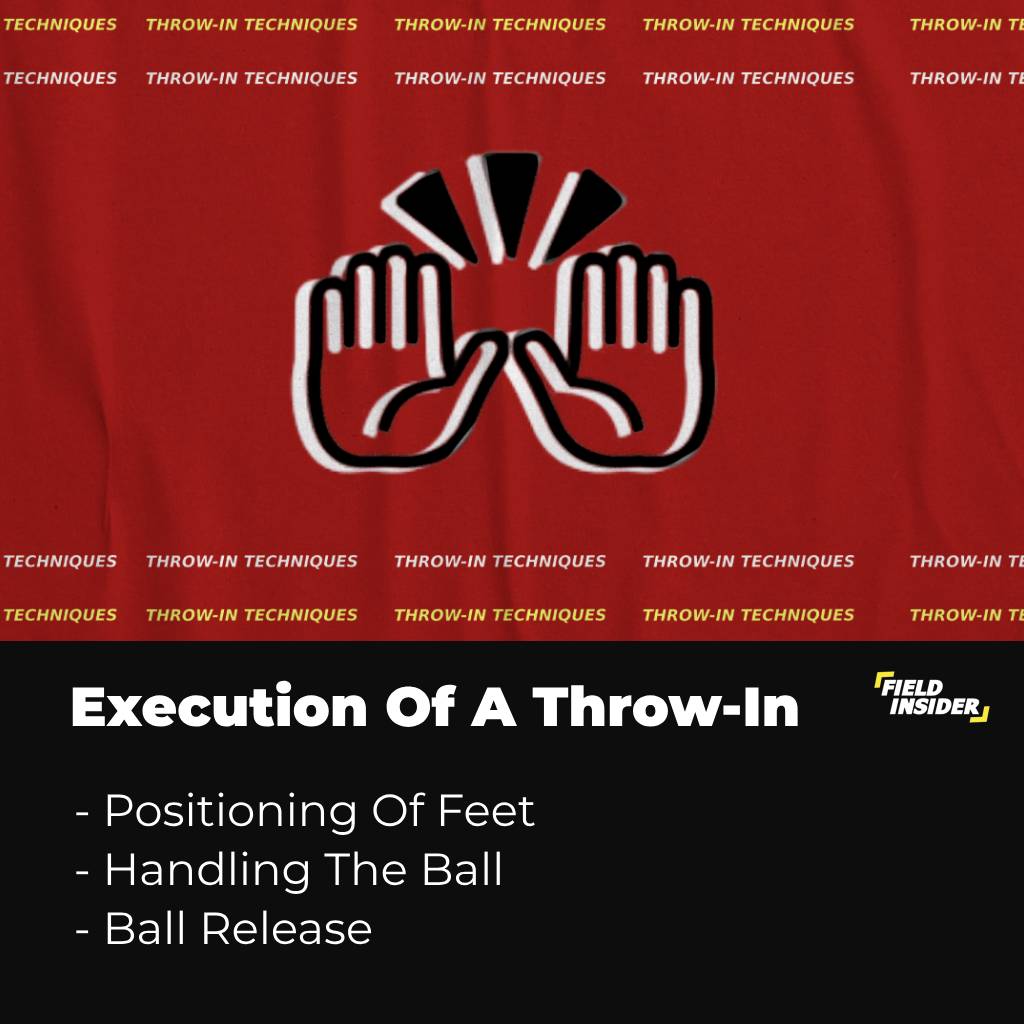
Legal Requirements for Taking a Throw-In
The throw-in must be taken from the point where the ball exited the field of play. Deviating from this spot can result in a foul throw. Additionally, the player must face the field of play and have part of each foot either on the touchline or outside the playing area.
Common Mistakes to Avoid During a Throw-In
Players often commit errors such as lifting their back foot off the ground while throwing, spinning the ball, or throwing from an incorrect position. These mistakes can lead to a turnover of possession, with the throw-in awarded to the opposing team.
The Impact of a Well-Executed Throw-In on the Game
A skillfully executed throw-in can have several strategic impacts:
- Creating Scoring Opportunities: A well-directed throw-in towards the opponent’s penalty area can set up scoring chances, especially if the team has players adept at aerial duels.
- Maintaining Possession: Throw-ins can be used to retain possession, allowing the team to regroup and strategize their next move.
- Quick Play Advantage: Quick throw-ins can catch the opposing team off-guard, potentially leading to advantageous situations for the throwing team.
- Throw-in Specialization: Some players have honed the skill of long throw-ins, effectively turning them into set-piece opportunities.
Key Throw-In Rules
Understanding the complexities of throw-in rules is essential. From the exact positioning of the player to the two-touch rule where the thrower cannot touch the ball again until another player has, each aspect plays a vital role.
Throw-in rules can be tough to grasp for some. But it is all about repetition and technique when it comes to throw-ins. To perform football throw-ins adequately and without any mistakes, a few throw in rules need to be kept in mind.
The thrower should be having his feet on the touchline. Or outside it, should face the field of play, and throw it using both his hands and over his head. During this process, the opposition players have to keep a sufficient distance of about 2 meters from the thrower. In order to allow him to throw the ball amicably.
If they do not do that, the referee can warn them before the throw-in occurs. And penalize them with a free kick after it is taken. The thrower should bend his back and throw it firmly trying to aim at the feet of his teammate.
Once a throw-in has been taken, it has to hit another person before the thrower can touch it again. It will be a foul throw if these throw-in rules are not observed accurately enough.
Is a throw-in considered a set-piece?
Yes it is. A set piece is any instance where the ball goes out of play or any foul is awarded to a team. So football throw-ins are set pieces because there is a halt in the proceedings of the game during the throw-in, as is the case with free kicks and corner kicks, the two other kinds of set pieces.
Being a set piece itself makes football throw-ins an opportunity to create an offensive opportunity as defenders can often lose concentration during a stop in the game.
Variations in Throw-Ins
The tactical application of throw-ins in football is diverse and can significantly influence a team’s strategy during a match. Different types of throw-ins serve various purposes, from launching attacks to maintaining possession or relieving defensive pressure. Let’s explore these variations in more detail:
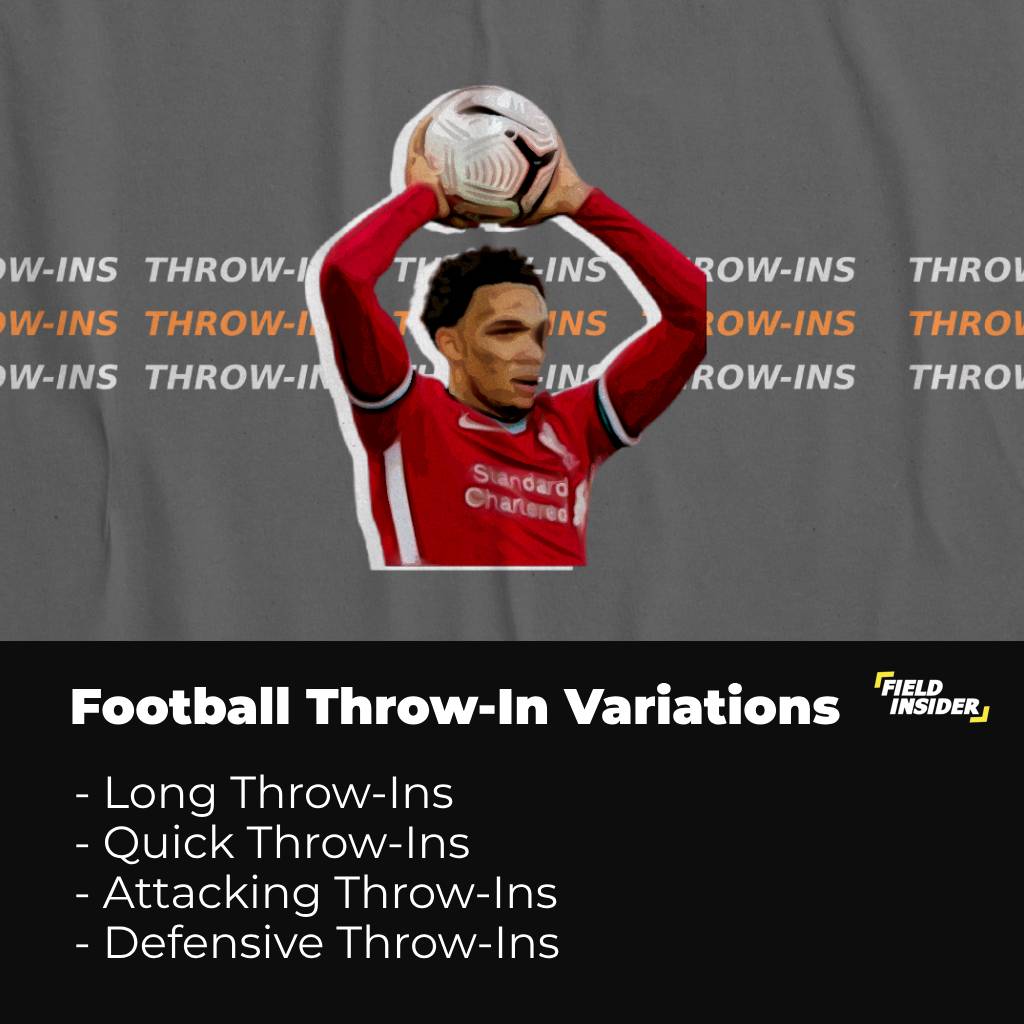
Long Throw-Ins and Their Tactical Uses
Long throw-ins are a crucial tool, especially when executed near the opponent’s penalty area. Here are some key aspects:
- Set-Piece Alternative: A long throw-in, when launched into the penalty box, mimics a corner kick or a free kick, creating scoring opportunities through headers or volleys.
- Specialist Throwers: Some players specialize in long throw-ins, using their strength and technique to hurl the ball great distances, often catching defenses unprepared.
- Creating Chaos: Long throw-ins can cause confusion and disarray in the opponent’s defensive setup, leading to chances for attackers to capitalize on loose balls or mismatches.
Quick Throw-Ins and Their Advantages
Quick throw-ins are an effective way to maintain the game’s tempo and can catch opponents off guard:
- Maintaining Momentum: Teams often use quick throw-ins to keep the game flowing, especially when in an advantageous position or looking to exploit a disorganized defense.
- Catching Defenses Unprepared: Quick throw-ins can be used to exploit a momentary lapse in the opponent’s concentration or positioning, potentially leading to goal-scoring opportunities.
- Transitioning from Defense to Attack: In counter-attacking scenarios, a quick throw-in can swiftly change the game’s dynamics from defense to offense.
Throw-Ins in the Opponent’s Half as an Attacking Opportunity
Using throw-ins in the opponent’s half can be strategically advantageous for following reasons;
- Positional Advantage: Throw-ins taken close to the opponent’s goal can be as valuable as corner kicks, offering a chance to deliver the ball into a dangerous area.
- Strategic Placement: Teams might position tall or physically strong players to receive these throw-ins, setting up headers or shots on goal.
- Drawing Fouls: In congested areas, attackers receiving the ball from throw-ins might draw fouls, leading to free-kick opportunities in advantageous positions.
Throw-Ins as a Defensive Tactic
Defensively, throw-ins can be used to alleviate pressure and reorganize:
- Relieving Pressure: When under intense pressure, a well-placed throw-in can help a team move out of their defensive third.
- Time Management: In situations where a team is leading, throw-ins can be used to manage the clock effectively, slowing down the game’s pace.
- Reorganizing the Team: Defensive throw-ins allow a team to regroup and reposition, especially after sustained periods of opposition attack.
In summary, the strategic use of throw-ins in football, whether for attacking purposes or defensive reorganization, is a vital aspect of the game. Understanding and exploiting these variations can provide teams with additional tools to gain an upper hand during a match.
significance of throw-ins
The research conducted by International Journal of Sports Science & Coaching backed the importance of throw-ins in the game. The conclusion derived from the said research is illustrated in the chart below;
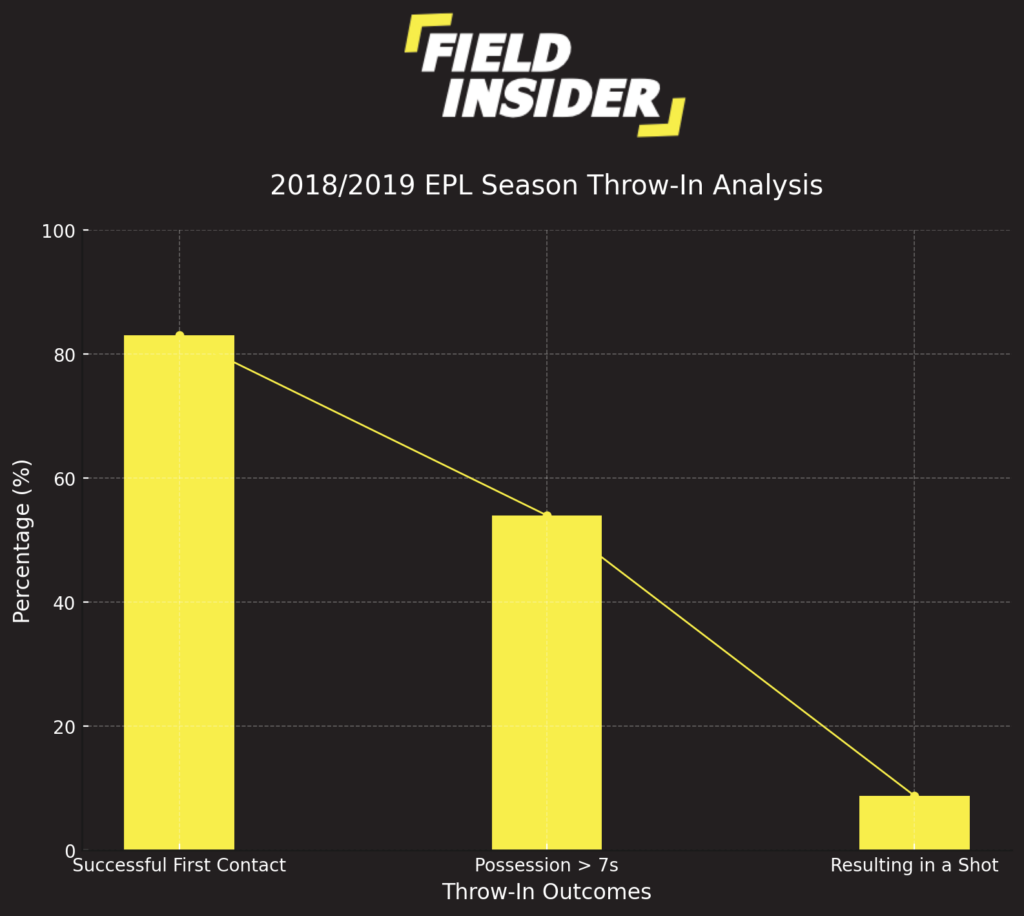
The 20 English Premier League teams were included in the sample. Raw coded data on throw-in phases of play was exported from each of the 380 games during the 2018/2019 English Premier League season from the Statsbomb database.
The bar chart visualizes three key statistics related to throw-ins from the 2018/2019 English Premier League season:
- Successful First Contact (83%): This indicates that in 83% of the throw-in instances, the team executing the throw-in managed to make successful first contact with the ball.
Successful first contact means the player from the throwing team was the first to touch the ball after it was thrown into play, which is a significant advantage for maintaining possession or creating an attacking opportunity.
- Possession Retained for >7 Seconds (54%): Out of all throw-ins taken, 54% resulted in the throwing team retaining possession of the ball for at least 7 seconds.
This retention time suggests a measure of control over the game, as the team was able to keep the ball and potentially set up a play or stabilize the game rhythm to their advantage.
- Resulting in a Shot (8.8%): Following a successful first contact, 8.8% of throw-ins led to a shot on goal. Although this percentage might seem low, it underscores the potential of throw-ins to create genuine scoring opportunities.
This can happen directly from the throw-in move or from subsequent passes that culminate in an attempt on goal.
Referee’s Role in Enforcing Throw-In Rules
The referee is key in enforcing throw-in rules, ensuring they’re executed correctly and penalizing any infringements. This enforcement is pivotal in maintaining the game’s integrity and fairness.
The Referee’s Responsibilities During a Throw-In
Referees have specific duties during a throw-in to ensure the game runs smoothly:
- Ensuring Correct Execution: The referee must ensure that the player executes the throw-in correctly, with both feet either on or behind the touchline, and the ball is thrown from behind the head using both hands.
- Spotting Foul Throws: If a player commits a foul throw (e.g., lifting a foot off the ground, improper ball release), the referee must award the throw-in to the opposing team.
- Monitoring the Throw-In Spot: The referee ensures that the throw-in is taken from the correct spot where the ball left the field of play. Deviations can lead to a turnover of the throw-in.
How Infringements are Identified and Penalized
The referee’s vigilance in spotting and penalizing infringements plays a significant role:
- Identifying Foul Throws: The referee must be alert to identify any deviations from the prescribed throw-in technique.
- Dealing with Delay Tactics: In cases where players deliberately delay a throw-in, the referee can penalize the player, typically with a caution (yellow card) for time-wasting.
- Ensuring Fair Play: The referee intervenes if any unfair tactics are employed during a throw-in, such as obstructing the thrower.
The Importance of Fair Play and Sportsmanship
Referees also play a part in upholding the spirit of the game:
- Encouraging Sportsmanship: The referee can encourage quick and fair restarts of play, maintaining the game’s flow and sportsmanship.
- Preventing Escalation: In situations where tensions might rise (e.g., disputed throw-in decisions), the referee’s role in defusing potential conflicts is crucial.
- Educating Players: Particularly in youth or amateur games, referees can take opportunities to educate players about proper throw-in techniques and rules.
The referee’s role in enforcing throw-in rules extends beyond merely monitoring for rule breaches. It involves maintaining the pace of the game, ensuring fair play, and upholding the spirit of sportsmanship.
Common Misconceptions and Myths
There are several misconceptions surrounding throw-in rules. Such being the belief that players can be offside from a throw-in (they cannot) or that a specific distance must be covered by the throw. This section aims to clarify these myths.
Offside from a Throw-In
One of the most prevalent misconceptions is the belief that a player can be offside from a throw-in. This is not the case. According to official football rules, a player cannot be in an offside position from a throw-in.
This means attackers can position themselves closer to the goal than the second-last defender without being penalized when receiving the ball directly from a throw-in.
Distance Covered by the Throw
Another common myth is regarding the distance a throw-in must cover. There is no rule stating that a throw-in must cover a specific distance before it becomes valid. A throw-in is considered legal as long as it adheres to the correct technique, regardless of how far the ball travels.
Player Positioning During a Throw-In
A common myth is that both feet of the player taking the throw-in must be completely behind the touchline.
In reality, the player must have part of each foot either on the touchline or outside the field of play. This means a player can have their toes on the line and heels off the ground, and it would still be a legal throw.
Can a goal be scored directly from a throw-in?
No, according to throw-in rules, a goal can not be scored directly from a football throw-in. If indeed the ball goes straight into the opponents net, the opponent team gets a goal kick.
And if it goes into the net of the person throwing the ball, the opponent team gets a corner kick.
Practical Tips for Players and Coaches
Mastering the art of throw-ins is not just a skill for players, but it’s also a strategic element that coaches need to weave into their team’s overall game plan. Here are practical tips for both players and coaches to make the most of throw-in situations:
Advice for Players on Mastering the Art of the Throw-In
- Perfecting Technique: Players should practice the correct throw-in technique — keeping both feet on or behind the line, throwing with both hands from behind the head, and ensuring a smooth, overhead release.
- Strength and Flexibility Training: Incorporating exercises to improve arm strength and flexibility can aid in executing longer and more accurate throw-ins.
- Awareness and Decision Making: Players should develop situational awareness to quickly decide between a long, short, or quick throw-in based on the team’s tactical needs and the positioning of teammates and opponents.
- Specialization in Long Throws: Those with a natural ability for long throws can specialize in this skill, turning throw-ins into potential goal-scoring opportunities.
- Practice Under Pressure: Simulating match-like pressure in training can help players get accustomed to making quick and effective decisions during throw-ins.

Coaching Tips for Improving Team Performance in Throw-Ins
- Tactical Training: Coaches should incorporate throw-in strategies into their team’s overall tactical training. This includes setting up plays for long throw-ins and practicing quick throw-ins to exploit unorganized defenses.
- Positioning Drills: Train players on optimal positioning during throw-ins, both for those taking the throw and those receiving it.
- Throw-In Plays: Develop specific throw-in plays, much like set-pieces, to create scoring opportunities or maintain possession.
- Analyzing Opponents: Encourage players to study opponents’ tendencies during throw-ins to exploit potential weaknesses.
- Rule Clarification Sessions: Regular sessions on rule clarifications can help players avoid common mistakes and understand the nuances of throw-in rules.
In short, throw-ins, while often underrated, are a vital aspect of football that require both technical proficiency and tactical intelligence.
Conclusion
Understanding the rules and strategic importance of throw-ins is crucial in football. This guide has covered the essential aspects, from basic rules to tactical applications, highlighting the role of throw-ins in the beautiful game.
For more insights into football tactics and formations, explore how they integrate with throw-in strategies in our articles on the 4-3-3 Formation, 5-a-side Defending, and the tactical nuances of the 9-a-side Football Rules.


